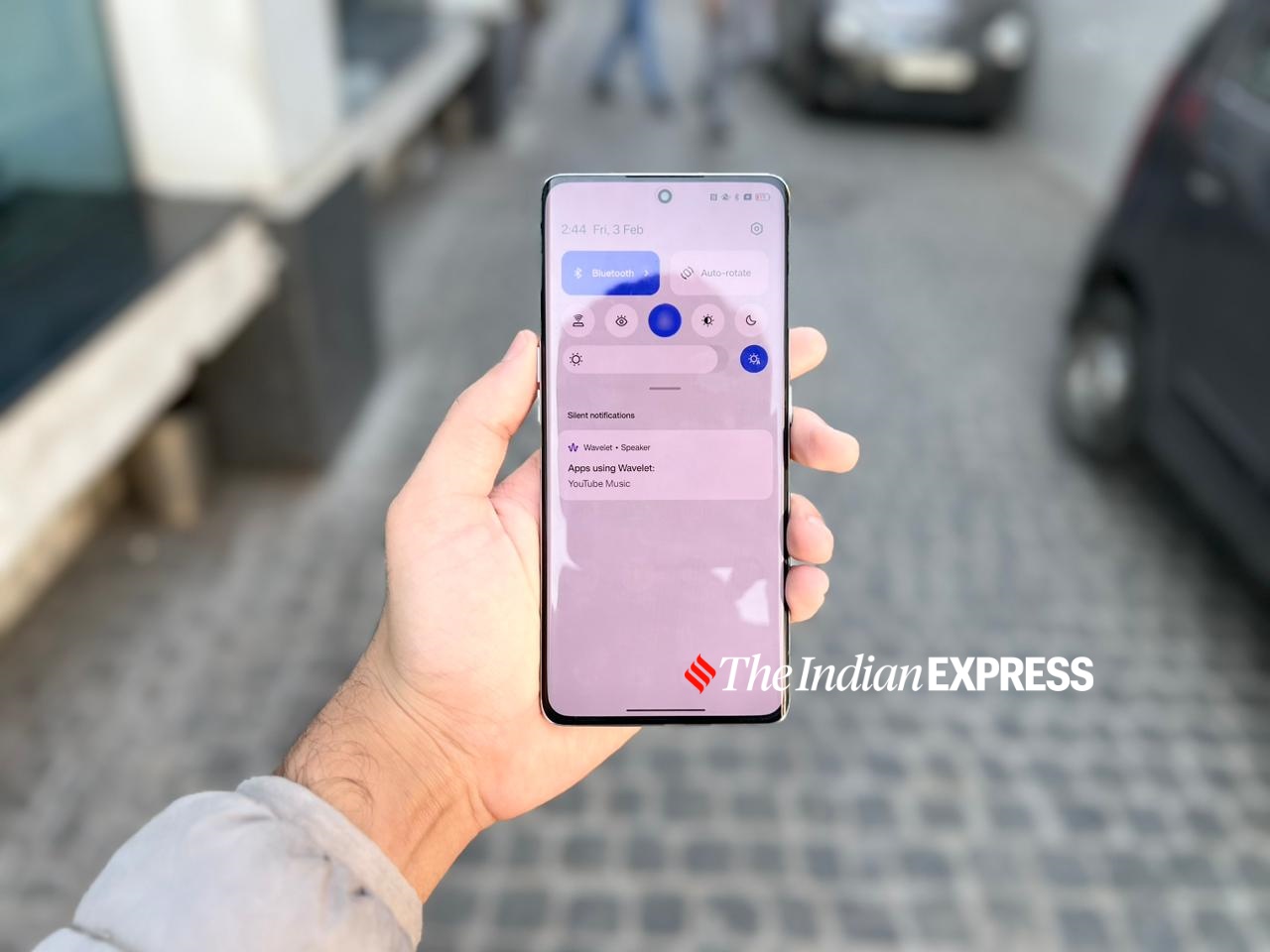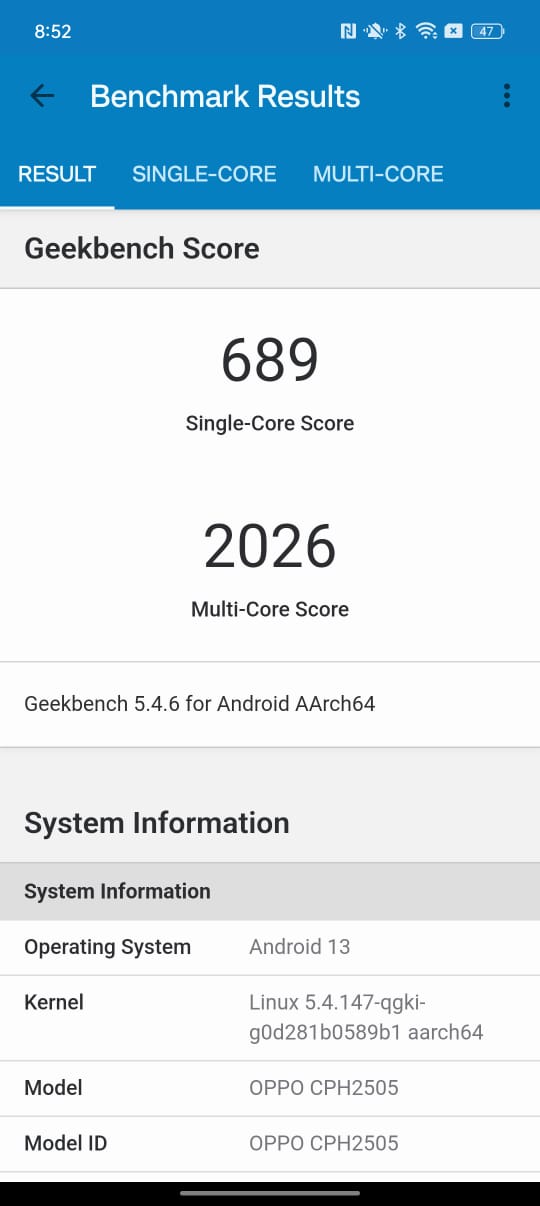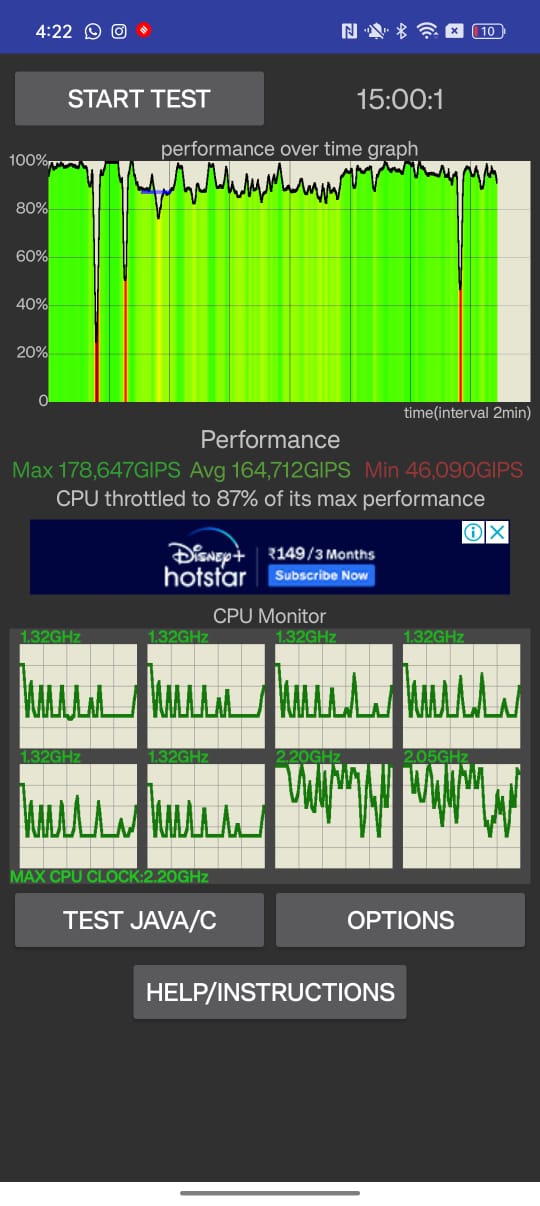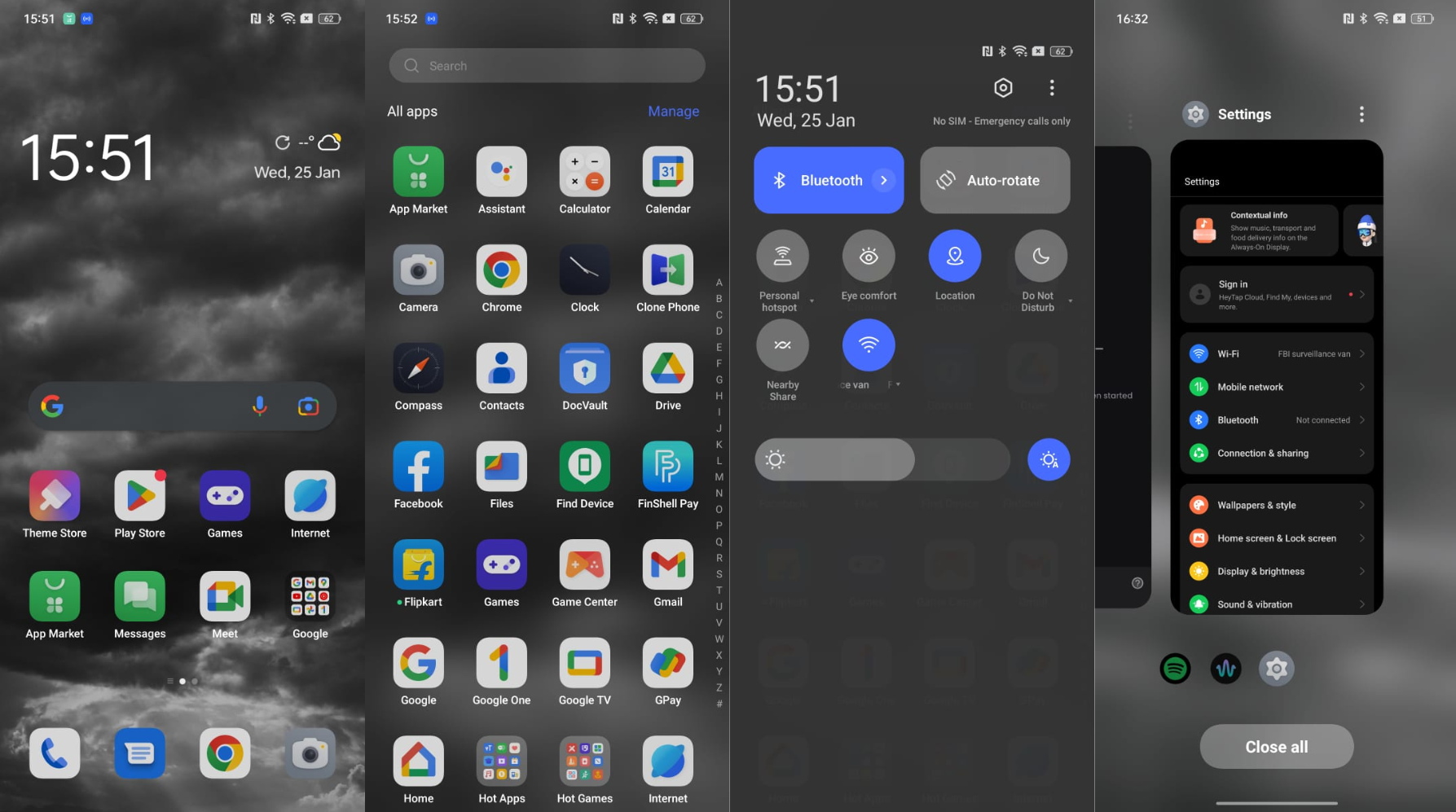The curved display trend was introduced by Samsung with the Galaxy Note Edge, whose funky asymmetrically curved screen tried to provide actual use cases. It caught on and other brands started implementing similar designs – although they gave a miss to the utility bit and billed the feature for its aesthetics. And aesthetic it indeed is – there is a certain wow factor to seeing the display flow over the edges. Oppo is aware of the effect it has on people and seemingly decided to turn the feature into the primary selling point of the Reno8 T 5G.
The phone loses out on the highly capable Dimensity 1300 chip from its predecessor in favour of the less blingy Snapdragon 695. That’s a significant downgrade, but I’m guessing it’s to make a curved display at its price point possible. So is a curved display worth the trade-off? That’s what I’ll be focusing on primarily with this review.

Design
I have the Sunrise Gold colour variant here for the review. And, it looks quite eye-catchy for the most part, with a glittery finish that is oddly satisfying to gaze at. Things get even better when you go out in the sun and turn the phone around a bit to get the entire spectrum of colours thrown at your face. But one element gets in the way of perfection – the virtual extension of the camera module. It does an excellent job of subduing the otherwise premium-looking rear panel. I had this overwhelming urge to scratch it out, as it mostly looks like a shoddy sticker. Regardless of how jarring it might be, I’m not getting adventurous on a review unit.
 The rear of the phone would have looked a lot cleaner without the sticker-like camera extension (Image credits: Zohaib Ahmed/Indian Express)
The rear of the phone would have looked a lot cleaner without the sticker-like camera extension (Image credits: Zohaib Ahmed/Indian Express)
I really liked how the cameras are put together, especially with the primary camera fitted into a large circular unit. Beneath that are the other two cameras which get a circular unit of their own. The first thing that came to mind when I set my eyes on the rear panel was “Huawei!” The camera module is obviously inspired by the one from the Huawei P50 – and I don’t mean it in a bad way.
Around the sides, you get a lustrous metallic finish, although it’s actually plastic like the rest of the phone. However, the plastic finish doesn’t compromise on how premium the phone feels in hand, thanks to an adequately slim profile (7.7mm) amplified by the curved edges on the back and the front. The weight is surprisingly light as well at 171g belying the size of the phone.
Display
But, the real fun starts when you flip the Oppo Reno8 T 5G to the front to reveal that gorgeous curved display. Thanks to extremely slim bezels all around, the 6.7” FHD+ 120Hz display is mostly the only thing you see upfront (as you should) – the giant chin from the Reno8 hasn’t been inherited, thankfully. The colours pop graciously whether you are watching a movie, gaming, or simply browsing around. But if they feel too poppy, the “Natural” screen colour mode will help turn down the saturation. I’ll go out on a limb and go as far as saying that the display looks flagship-level – the entire front of the device does, honestly.
 The front of the Oppo Reno 8T looks like it belongs on a flagship phone (Image credits: Zohaib Ahmed/Indian Express)
The front of the Oppo Reno 8T looks like it belongs on a flagship phone (Image credits: Zohaib Ahmed/Indian Express)
Performance
The Snapdragon 695 is this year’s OEM-favourite with mid-rangers. It’s a proven performer, and while it’s no beast, it sails through everyday tasks thanks to Oppo’s applaud-worthy ColorOS optimisation. Choppy scrolling on apps like Reddit and Twitter is a particular source of vexation for Android users, but the Reno8 T 5G handles that surprisingly well. I did not notice any lags and stutters in the UI either.
Story continues below this ad
 Geekbench scores are about what you’d expect from a SD695 (Express photo)
Geekbench scores are about what you’d expect from a SD695 (Express photo)
What did bother me, though, was the Reno’s performance when I ran the stress test. Where just about every review unit I’ve had in recent times stayed in the green for around 30 minutes, the Reno kept slipping down into the red and orange zones every few minutes or so, no matter how many times I ran the test. Exiting the app to a choppy UI proved that something was clearly amiss, even as the phone did not heat up at all. My best guess is that a software optimisation issue is preventing the Reno8 T from realising its true potential in this test.
 There were unusual performance dips during the test (Express photo)
There were unusual performance dips during the test (Express photo)
But as I found out soon enough, the stress test wasn’t the only place the Reno8 T fell short. Call of Duty: Mobile on the highest possible settings, although playable, was far from a smooth experience due to micro-stutters. That could be an optimisation issue again since New State Mobile ran perfectly fine on Lite graphics and Max framerate. FYI, Lite is the highest the game can go graphically if you want to play at 60FPS.
The Snapdragon 695 is a lower-mid-range processor, so if you are a gamer, be prepared for compromises like these. On the bright side, while the phone does warm up a little during extended gaming sessions, it was nothing that would burn your hands.
Software
Software is easily one of the strongest selling points of this phone. I happen to be one of those hardcore stock Android stans who aren’t particularly fond of any other skins on the market due to their over-the-top designs. I also hadn’t used ColorOS in a while so when I booted for the first time into its Android 13 version, I was blown away by how well it’s put together now. The skin manages to be both minimalistic and highly customisable at the same time somehow. Whether it’s system colours, quick settings, icons, launcher, fingerprint animation, AOD – every bit of the software can be personalised. I switched to round icons and the One Sans font and instantly drowned in OxygenOS nostalgia.
Story continues below this ad
 ColorOS is one of the cleanest Android experiences around (Image credits: Zohaib Ahmed/Indian Express)
ColorOS is one of the cleanest Android experiences around (Image credits: Zohaib Ahmed/Indian Express)
So stock Android lovers, if you want to try something new for a change, ColorOS is definitely the way to go.
Camera
Oppo has made some odd choices in the Reno 8T’s camera department, skipping on an ultrawide sensor completely. What you get instead is a 108MP snapper — the only unit at the back dedicated to everyday photos. The other two are the 2MP depth sensor and a 2MP microscope, with the former seemingly existing just to take the lens count up.
Firing up the camera app for the first time led me to believe that the Reno 8T packs absolutely trashy cameras thanks to a very low-quality stream on the viewfinder. That opinion changed immediately when I snapped a photo, though — for some reason, the final result is always starkly different from what you see initially.
 You can zoom in plenty to this shot (Image credits: Zohaib Ahmed/Indian Express)
You can zoom in plenty to this shot (Image credits: Zohaib Ahmed/Indian Express)
The 108MP sensor does a great job in well-lit conditions, preserving a lot of detail and allowing you to crop into photos later if you wish to. While Oppo’s image algorithms sure take their sweet time to process images, the focus seems to be on improving detail rather than on needless colour enhancements. As a result, the output is quite natural, while being Instagram-worthy.
Story continues below this ad
Indoor photos are a lot harder to get right, though, because you’ve to keep your hand impossibly steady while shooting. Any movement and you’ll end up with shaky output. Check out the indoor sample below which I gave up on after trying to click a steady shot three times. On the rear chance you do get a stable shot, images are fairly crisp as apparent from the fine details on the tree shot below.
 I tried to get everything in focus thrice but failed (Image credits: Zohaib Ahmed/Indian Express)
I tried to get everything in focus thrice but failed (Image credits: Zohaib Ahmed/Indian Express)
 The tree looks fairly detailed here (Image credits: Zohaib Ahmed/Indian Express)
The tree looks fairly detailed here (Image credits: Zohaib Ahmed/Indian Express)
The 2MP microscope lens is a joy to use. There’s a bit of scuffling involved to get the object into focus, but when you do you’ll be surprised by how smooth-looking everyday objects appear a lot bumpier up close.
 Who could’ve thought that a mid-range smartphone could be capable of capturing such images? (Image credits: Zohaib Ahmed/Indian Express)
Who could’ve thought that a mid-range smartphone could be capable of capturing such images? (Image credits: Zohaib Ahmed/Indian Express)
Verdict
 You get an 80W brick in the box despite the phone supporting 67W, which fills the 4,800mAh to the brim in around 45 minutes (Image credits: Zohaib Ahmed/Indian Express)
You get an 80W brick in the box despite the phone supporting 67W, which fills the 4,800mAh to the brim in around 45 minutes (Image credits: Zohaib Ahmed/Indian Express)
The Oppo Reno 8T is built for someone who isn’t a “power” smartphone user. Its main selling points are its excellent lightweight design and the flagship-level curved display. Add to that a clean software experience, which makes everyday usage an absolute delight. The camera module misses out on the now-crucial ultrawide lens but is otherwise okay for the price. But if you game a lot on your phone, then the Snapdragon 695 will fall short. You won’t see many phones with this particular chip in this price range — the Reno 8T is eccentric that way.



 The rear of the phone would have looked a lot cleaner without the sticker-like camera extension (Image credits: Zohaib Ahmed/Indian Express)
The rear of the phone would have looked a lot cleaner without the sticker-like camera extension (Image credits: Zohaib Ahmed/Indian Express) The front of the Oppo Reno 8T looks like it belongs on a flagship phone (Image credits: Zohaib Ahmed/
The front of the Oppo Reno 8T looks like it belongs on a flagship phone (Image credits: Zohaib Ahmed/ Geekbench scores are about what you’d expect from a SD695 (Express photo)
Geekbench scores are about what you’d expect from a SD695 (Express photo) There were unusual performance dips during the test (Express photo)
There were unusual performance dips during the test (Express photo) ColorOS is one of the cleanest Android experiences around (Image credits: Zohaib Ahmed/Indian Express)
ColorOS is one of the cleanest Android experiences around (Image credits: Zohaib Ahmed/Indian Express) You can zoom in plenty to this shot (Image credits: Zohaib Ahmed/Indian Express)
You can zoom in plenty to this shot (Image credits: Zohaib Ahmed/Indian Express) I tried to get everything in focus thrice but failed (Image credits: Zohaib Ahmed/Indian Express)
I tried to get everything in focus thrice but failed (Image credits: Zohaib Ahmed/Indian Express) The tree looks fairly detailed here (Image credits: Zohaib Ahmed/Indian Express)
The tree looks fairly detailed here (Image credits: Zohaib Ahmed/Indian Express) Who could’ve thought that a mid-range smartphone could be capable of capturing such images? (Image credits: Zohaib Ahmed/Indian Express)
Who could’ve thought that a mid-range smartphone could be capable of capturing such images? (Image credits: Zohaib Ahmed/Indian Express) You get an 80W brick in the box despite the phone supporting 67W, which fills the 4,800mAh to the brim in around 45 minutes (Image credits: Zohaib Ahmed/Indian Express)
You get an 80W brick in the box despite the phone supporting 67W, which fills the 4,800mAh to the brim in around 45 minutes (Image credits: Zohaib Ahmed/Indian Express)





